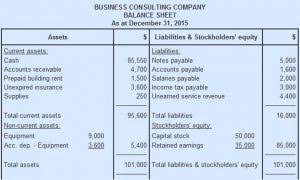Like updating your playlist for your current mood, you tweak your projections to reflect the here and now. Maybe it’s a sudden tech upgrade because your current system decided to take an unplanned vacation. Think of the cash reserve as your emergency snack stash, always there to save the day. In the startup realm, expecting the unexpected isn’t just a cool phrase; it’s survival 101. Before you sprint ahead, you gotta know the lay of the land.
Balance sheet
For example, when you invoice a customer you’re probably not going to get paid for 30 days or 60 days. That is a working capital cost and that’s going to be reflected on your balance sheet and cash flow statement. Just be aware of all the changes to working capital, all the prepaid expenses that you have to do, all the accrued expenses. Those are going to https://financeinquirer.com/navigating-financial-growth-leveraging-bookkeeping-and-accounting-services-for-startups/ all get flushed out on the balance sheet and cash flow statement. Financial projections are estimates of the future financial performance of a company. These projections are typically based on a set of assumptions and are used to help businesses plan for the future and make informed decisions about investments, financing, and other strategic matters.
Plan for future success with HubSpot for Startups
However, the aim is always to be as accurate and realistic as possible. It’s a crucial step in charting the financial course of your startup’s journey. Cash is the lifeblood of your startup, and a cash flow accounting services for startups forecast helps you ensure your business has a healthy pulse. A P&L forecast, like the other elements of your financial forecast, is a crucial tool for demonstrating your business’s potential to investors.
- Each is going to read and understand your projections through the lens of their own perspective.
- We cannot stress enough how important it is to ensure you’re using reliable data sources for forecasting.
- The viability, investability and valuation of your startup are heavily dependent on growth potential and final profitability margin.
- My recommendation is to use excel as some investors don’t use Gmail thus won’t be able to get your shared link, and if you use Google Spreadsheet, some of the design will be lost when converting to Excel.
- While it is possible to use data from your competitors to build bottom-up projections, every business operates differently—so we don’t recommend taking this approach.
Why do investors care so much about them?
Imagine for a moment that you’re about to embark on a road trip. You’ve got your destination in mind, your bags are packed, and you’re ready to hit the open road. Before setting off, you’d most likely plan out your journey, calculating the distance, the time it’ll take, the amount of gas you’d need, and even your pit-stops for food and rest. This road map isn’t just a smart preparation step; it’s your guideline, your navigation system to reaching your destination successfully.
- It’s vital that you stay realistic and do your utmost to create an accurate, good-faith projection of future income.
- Therefore instead of working from real-world data to build our income statements, startups have to use a handful of assumptions about these values to create a solid financial projection.
- For starters, you’ll need to project how much your business will make in sales.
- If the industry has an exceptionally long cash cycle or includes a large upfront inventory investment, then an annual cash implication estimate should be made on those pieces.
- The question is more about how many trucks do you have, how many miles per day can each truck drive and what price will you be able to earn per mile.
Importance of having a cash reserve
The early growth of companies like Bolt, Monzo and Babylon Health is public information. This information can be difficult to find, depending on your industry. If you do find it and would like to share it with other founders, please email us at info at equidam.com, we’d love to help on this and collect these resources for the future. You can find gross and net profit margins of publicly traded companies here and here.
Present your projections in a clear, organized manner, highlighting key metrics and trends. Remember, your financial projections tell the story of your startup’s potential journey to success. Make sure it’s a story that captivates your audience and convinces them to join you on this exciting ride. So, how do you create these financial projections for your startup? The process involves a combination of careful research, thoughtful assumptions, and a bit of financial savvy.
- What if your costs turn out to be double of what you expected?
- In this article, we cover all the basics you need to start defining and generating startup financial projections.
- A monthly calculation is helpful if your revenue driver is new clients, as clients will be attained throughout the year and will not provide a full year’s revenue in year 1.
- Every road trip has its share of expenses, and your startup journey is no different.
- Plus, by changing variables in the financial model—such as altering product pricing or team headcount—you can see how these factors will affect the projected revenue and expenses.
Investors want to see you’ve thought things through, that there’s a plan for their money. Financial projections for startups paint a picture of potential ROI, risks, and growth. You know that feeling when Spotify just gets your music mood right? Well, when it comes to financial projections for startups, it’s more than just a game. But diving into financial projections for startups without a plan can feel just as daunting.
Accurate revenue forecasting requires a clear understanding of how a company will generate sales. A sales capacity model (in conjunction with the headcount plan) will help you to estimate the performance of your sales team and the revenue they expect to generate. Examples include balance sheets, profit and loss (P&L) statements, and cash flow statements. The inclination when creating a startup financial model is to blow these numbers through the roof, creating hyper-ambitious expectations and doubt among investors regarding your competence and rationality. Once you’ve created your financial projections, it’s time to share them with potential investors, stakeholders, and even your team.
How to Create a Robust Startup Financial Model (Tips and Examples) DigitalOcean
Financial projections are useful for businesses looking to obtain bank loans or raise capital from investors. These insights are a crucial component of any fundraising presentation since they assist potential investors in determining if a startup is a worthy investment. A business’s ability to plan how it will spend the funds it is asking for and how those funds will help the company expand is something that investors look for in a startup. Not only can you access that real-time data instantly, but you can also use it to create forecasts and projections for multiple scenarios without any need to create manual financial models.
While revenue projections set the stage for potential earnings, understanding costs and capital expenditures is crucial to measure the profitability and sustainability of your startup. A thorough breakdown of costs ensures you’re not caught off guard by unexpected expenditures. A robust startup financial model isn’t just a tool—it’s a lifeline. It provides clarity on revenue streams, expenses, and capital allocation, giving you the data you need to make informed decisions.
Consult with your team members, including the CFO, Sales VP, business owners, heads of various divisions, etc., to ensure you have all the data and viewpoints needed to create reasonable projections. Cash flow projections show the inflow and outflow of funds for your company over time. Consider variables like seasonality, inventory turnover, accounts payable, and receivable.



